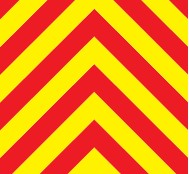PLEASE NOTE: the member portal is under maintenance
Retroreflective Striping and Chevron
FAMA BUYER’S GUIDE TC043 Retroreflective Striping and Chevron
Retroreflective Striping and Chevron
Prepared by the FAMA Body Subcommittee
This guide does not endorse any manufacturer or product

Contents
Introduction
Retroreflective striping on fire apparatus has been listed as a guideline in NFPA 1901 dating back to 1991. The 2009 edition of NFPA 1901 added rear body chevron reflective striping and it remains in the current edition. As defined in the National Highway Traffic Safety Administration (NHTSA), and adopted by NFPA, the purpose of retroreflective striping is to reduce traffic accidents and deaths and injuries resulting from traffic accidents, by providing adequate illumination of the roadway, and by enhancing the conspicuity of motor vehicles on the public roads so that their presence is perceived and their signals understood, both in daylight and in darkness or other conditions of reduced visibility.
By definition, retroreflective tape is a film that either through the use of glass spheres or man-made prisms, reflects light or radiation back to its source. Different marking patterns can change driver responses. The association of the down-and-away chevron pattern with a “danger” or “slow down” message is recognized because of its widespread use on traffic barriers,
Firefighter Line of Duty Deaths (LODD) relating to the fire apparatus itself, whether in route to a scene or on a scene, is the second leading cause of death and amounts to approximately 25% of the total.
Overview
NFPA 1901 Standard for Automotive Fire Apparatus, NFPA1906 Standard for Wildland Fire Apparatus, and NFPA 1917 Standard for Automotive Ambulances have very specific guidelines for vehicle conspicuity. NFPA also mentions that all retroreflective materials shall conform to ASTM D4956, Standard Specification for Retroreflective Sheeting for Traffic Control, Section 6.1.1 for Type 1 Sheeting. This is a highly technical publication and uses formulas such as: Minimum Coefficient of Retro-reflection (RA) cd/fc/ft2(cd·lx−1·m−2).
NFPA 1901 also is specific in the colors of the rear chevron material. The image shown covers the NFPA approved colors.
When specifying retroreflective striping on fire apparatus whether the installation is performed by the apparatus manufacturer, a third party installer or installing it yourself, NFPA compliance should be specified. This should cover the technical aspect of retroreflectivity.
This guide will list the specific installation areas in NFPA and show examples of each.

Vehicle Coverage
FRONT OF VEHICLE
A minimum of a 4.00 in. stripe that covers at least 25% of the width of the front of the apparatus. The stripe may be interrupted by vehicle installed items.
VEHICLE SIDES
A minimum of a 4.00 in. stripe that covers at least 50% of the side of the cab and body on each side excluding the pump panel area. The stripe may be interrupted by vehicle installed items.
REAR OF VEHICLE
At least 50% of the rear facing vertical surfaces covered in a chevron pattern with alternating 6.00 in. red and 6.00 in. approved yellow stripe sloping downward and away from the centerline of the vehicle at a 45 degree angle.
Additional Considerations
GRAPHIC DESIGNS
A retroreflective graphic design is allowed to replace all or part of the front and side striping requirements as long as it meets the coverage requirements of the front and side areas.
CREW ENTRY DOORS
Any entry door in the cab or body should have at least 96 square inches of retroreflective material installed on the inside of the door that will be visible to traffic from the rear.
AERIAL DEVICES
Where the design of an aerial device incorporates a knuckle it should be painted with a reflective paint or provided with retroreflective tape.
All vehicle stabilizers that protrude outside of the body should be provided with retroreflective material to indicate a hazard.
INSTALLATION
Installation of the retroreflective material on to the vehicle may be performed by the apparatus manufacturer, a third party installer or the end user. Since the retroreflective material goes across many body and cab mounted items, these items will need to be removed if applied after the truck is built. These materials can be challenging to apply especially on items like roll up doors. To avoid removing installed parts and for the best professional installation, FAMA recommends that the apparatus manufacturer apply the material while the truck is being built.
STATEMENT OF EXCEPTION
End users may want to change the chevron colors to compliment the color scheme of their vehicle. The apparatus manufacturer will ask that a Statement of Exception (waiver) to the NFPA guideline is signed by a responsible party if chevron stripe colors, other than the NFPA approved colors, are applied to the vehicle.
NFPA 1906 Guidelines, Wildland Fire Apparatus
The guidelines for NFPA 1906 are the same as NFPA 1901 with the exception that the coverage at the rear of the vehicle does not have to be in a chevron pattern and may be one color.
NFPA 1917 Guidelines, Ambulances
The guidelines for NFPA 1917 are similar to NFPA 1901. The specific requirements are listed below.
A minimum of a 6.00 in. stripe that covers at least 25% of the side of the cab and 75% of the body on each side. The stripe may be interrupted by vehicle installed items.
At least 50% of the rear facing vertical surfaces covered with a retroreflective material. If chevrons are used, each stripe should be 6.00 in. wide with the two colors in high contrast.
A retroreflective graphic design is allowed to replace all or part of the striping requirements as long as it meets the coverage requirements.
Any entry door in the cab or body should have at least 60 square inches of retroreflective material installed on the inside of the door that will be visible to traffic from the rear.
Summary
The NFPA guidelines for vehicle conspicuity have been put in place to improve the visibility of emergency vehicles with the ultimate goal of reducing death or injury caused by accidents while parked on the scene.
